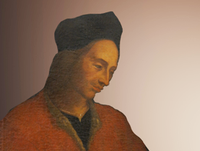Known as “the second Aristotle” by his contemporaries, Alessandro Achillini was a worthy representative of humanistic culture at the turn of the 15th and 16th centuries. A physician and philosopher, he associated himself with the Aristotelian-Averroist movement promoted by the followers of Siger of Brabant, who were partly influenced by the opposing Neoplatonic philosophy.
 Born in Bologna in 1463, the year in which Giovanni II Bentivoglio came to power, Alessandro Achillini studied at the Alma Mater Studiorum, graduating in Philosophy and Medicine in 1484 (Giovio claimed that he also attended the University of Paris for three years).
Born in Bologna in 1463, the year in which Giovanni II Bentivoglio came to power, Alessandro Achillini studied at the Alma Mater Studiorum, graduating in Philosophy and Medicine in 1484 (Giovio claimed that he also attended the University of Paris for three years).
He then entered the ranks of university professors: first as a lecturer in Logic (1484-1487), Natural Philosophy (1487-1494), and Theoretical Medicine (1494-1497); later as a doctor of both the latter two disciplines (1497-1506).
Right from the start he used the press as a new and effective means of promoting his discoveries and reflections. Thus, he published in Bologna the Quodlibeta de intelligentiis (1494), on Averroistic and fideistic research, the four books of the De orbibus (1498), on the concentric conception of the spheres on which the planets rotate as opposed to the Ptolemaic one, the Opus septisegmentatum together with six pseudo-Aristotelian works (1501), the De intellectu (1501) by the Greek Alexander of Aphrodisia, the De animae beatitudine (1501) by Averroè, the Quaestio de subiecto chyromantiae et physionomiae (1503), dedicated to his friend the astrologer and fortune-teller Bartolomeo della Rocca (the volume was included in the Index of Prohibited Books in 1590), the Quaestio de potestate syllogismi, the Quaestio de subiecto medicinae (1504), where he continued the investigations of Mondino de' Liuzzi, and the De elementis (1505).
His role as a renowned humanist intertwined with that as an indispensable courtier of the Bentivoglio court and a great supporter of the Università degli Artisti, in which Achilini was enrolled. This inevitably led to his escape when, in 1506, Pope Julius II regained possession of the city, sending not only Giovanni II and his family into exile, but also nobles and intellectuals who had been their supporters.
Achillini thus repaired to Padua, where he was offered the professorship of Natural Philosophy, previously held by Pietro Pomponazzi.
At that time, the Venetian city was a hotbed of Aristotelianism, in stark contrast to the Florentine Neo-Platonic school. Even within Aristotelianism there were different currents of thought, more or less faithful to the medieval interpretation given by Averroes, and the two professors then at the height of their careers wasted no time in clashing.
In 1508, Achillini returned to Bologna where he resumed teaching Philosophy and Medicine until 1512, the year of his death (he is buried in the church of San Martino Maggiore)
The De distinctionibus (1510) and the fragment of the De physico auditu (1512) on the bony composition of the ear date back to the latter period, while the De proportionibus motuum (1516) and the Anatomicae annotationes (1520) are posthumous.
Achillini's entire literary production (except for the Anatomicae annotationes) was later printed in Venice in 1545 by his pupil and substitute, Panfilio dal Monte, whose palazzo on via Galliera is today the university seat of the Interdisciplinary Research Centre for Legal History, Philosophy and Sociology of Law, and Legal Informatics.
His heterogeneous, eclectic culture, often intertwined with occult disciplines, made him an unusual and magnetic character, capable of attracting students to his lessons as simple listeners, ready to utter the motto “aut diabolus aut Achillinus”.
His fellow countryman Amico Aspertini put in images this wandering, whirling intelligence in a portrait now displayed at the Uffizi Gallery. There was certainly an affinity between the two in terms of extravagance and expressiveness, and the Bolognese artist managed to immortalise the “devilish” professor in the guise of a melancholic free spirit in worn, threadbare clothes.
